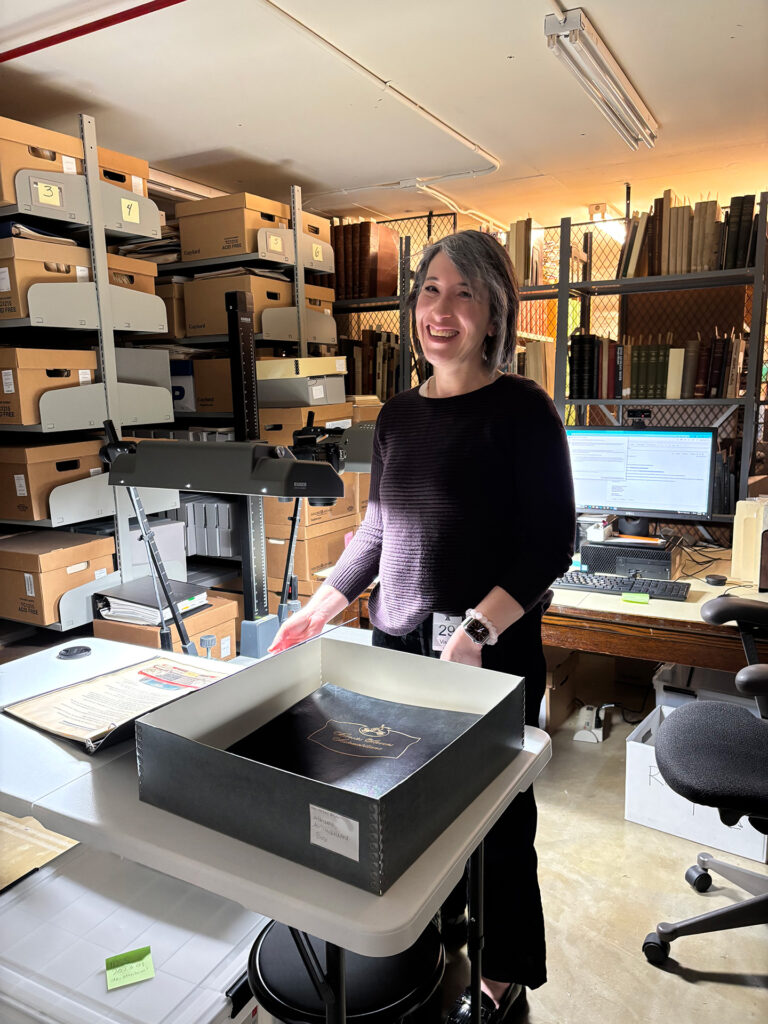by Rebecca Silber, UW-Milwaukee School of Information Studies

As part of the Recollection Wisconsin Digitization Initiative, I was delighted to be paired up with the Milwaukee Art Museum (MAM) this spring, as a student participant. I hold a BFA and have a background in design, and so spending the semester focusing on digitizing, creating descriptive information for and providing public access to materials from the Brooks Stevens Archives is truly a task that I have appreciated throughout these last several months.
Admittedly, I didn’t know much, if anything, about Brooks Stevens prior to this fieldwork assignment. In case you don’t either, take a look at the Meet Team Milwaukee Art Museum blog post to learn more about both this talented industrial designer and the Milwaukee Art Museum Team.
There have been two aspects of this project that will stick with me long after I turn in my MAM badge at the end of this internship. The first aspect is what I have both learned, and have not learned, about Brooks Stevens as I work through this collection. The second aspect is that I am hopefully helping future researchers by providing access to this fantastic collection.
Brooks Stevens, Do I Know Him?
The other week on my UWM Fieldwork online discussion board, my classmates and I were discussing our various internship assignments for the semester. As we have been habitually doing every other week, we share a bit about the goings-on in our collections. I shared about the various materials I was digitizing, ranging from automobile photos to professional head shots to greeting cards. A classmate, and fellow Recollection Wisconsin cohort member, replied to my post by asking, “I wonder, as you work through it all, do you feel like you’ve gained some sense of not just what Brooks Stevens did but what he was like?”

I’m in a unique position, spending all of these internship hours poring over the materials belonging to one man. I have digitized photos of Stevens in jaunty suits shaking the hands of fellow businessmen and I have read letters written to him when he was hospitalized at St. Mary’s Hospital in Milwaukee. I have also heard some stories about Stevens that have been shared with me by the amazingly talented group I am lucky to work with at MAM—Frank Violette Foss, Heather Winter and Beret Kohn. And, yet, I most definitely have gained tremendous insights about what Stevens did, but I do not have strong sense of what Stevens was like. At least, not as strong of a sense as I would have had I actually spent all of this time with Brooks Stevens, himself.
Without spending a lot of time in this post discussing archival theory, this was an important reminder to me that I am digitizing physical materials that were left behind by Brooks Stevens. Archived collections belonging to anyone can’t fully give a strong sense of what someone was like, in all of their various dimensions, and all aspects of their personalities and lives. However, I do think that I have gained some sense of what Brooks Stevens was like, and I hope that through digitizing these collections, I am giving others the opportunity to also gain some sense of what Brooks Stevens was like, along with what he did.
Helping Future Researchers

That sentiment serves as a segue into the other aspect of this project that will stick with me long after this internship is over: helping researchers by providing access to the Brooks Stevens Collection. In my Archival Outreach: Programs and Services course, we are currently learning about researcher services including the different needs of archive users and how archivists can meet those needs.
Digitizing materials plays a big part in meeting researchers’ needs because researchers can search collections remotely, with less physical handling of the materials. When these materials and records are searchable on the Recollection Wisconsin website, we are helping to further the mission to preserve, promote, and facilitate digital access to Wisconsin’s rich history through collaboration and shared infrastructure. In addition, these materials will be accessible in MAM’s online records, providing further access to researchers.
I am honored to play a small role in the Brooks Stevens Collection digitization project. It’s exciting to me that the work I have done at MAM this semester has the potential to help researchers from various places gain insights into the work and life of Brooks Stevens, an extremely talented industrial designer who lived and worked in Milwaukee.
The Recollection Wisconsin Digitization Initiative brings together Wisconsin content partners and information school graduate students to create new digital collections. Content partners will choose collections to digitize, and student staff will handle the digitization, metadata work, and project documentation creation as part of a paid practicum or independent study experience. Most digitized collections will be added to Recollection Wisconsin throughout the year. Thanks to the State of Wisconsin for funding this important work!
Rebecca Silber lives in Milwaukee, Wisconsin and began studies at the University of Wisconsin-Milwaukee’s School of Information Studies (SOIS) in January 2024. She is working toward an MLIS degree with an archives concentration. Rebecca has a particular interest in archival outreach and promoting the use of archives.



You must be logged in to post a comment.